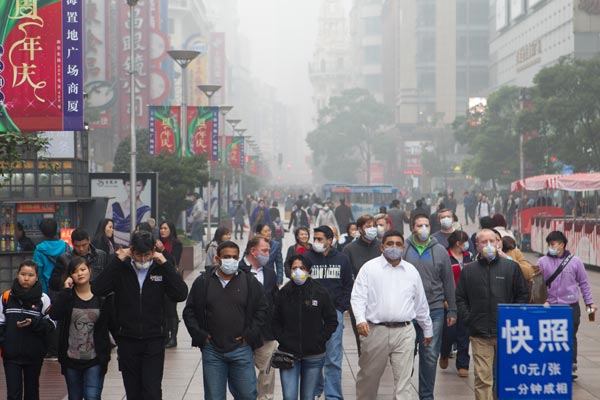Shanghai steps up air-pollution fight
Updated: 2014-11-28 13:20
By Li Yang in Shanghai(China Daily USA)
|
||||||||
|
Expats put on masks as they walk along Nanjing Road in Shanghai in this photo taken in December 2013. Gao Erqiang / China Daily |
Shanghai will research air-pollution sources affecting the city and publicize them regularly, the city environmental protection bureau announced last week.
Shanghai has fewer cars than New York. Why is Shanghai's smog much more serious than New York's? a people's representative asked in a face-to-face meeting with representatives of Shanghai's government and departments last week.
Shanghai started reporting the density of PM2.5, particulate matter smaller than 2.5 micrometers in diameter, in the air each day from 2013.
Since then, local residents' attention to air pollution has risen. The formation, source and changes of MP2.5are now hot topics among the people.
According to the Shanghai environmental monitoring center, local industrial emission contributes 25 percent of the PM2.5 in Shanghai; motor-vehicle and other transportation 20 percent; 20 percent from local dust and volatile organic compounds, and the rest - 35 percent - floating from outside Shanghai.
The air pollution caused by PM 2.5 affects a large area in North China and East China, from Beijing in the north to Shenzhen in the south.
In North China, the main source of smog in China, only the cold north wind can bring away self-made PM 2.5. Yet, the north wind is the main carrier of the air pollutants for Shanghai.
The highest density of PM2.5 in Shanghai so far came on Dec 6, 2013, a cold, windy day, when the average density reached 602 micrograms per cubic meter of air, more than 10 times higher than the safety line drawn by the World Health Organization.
The Shanghai environmental protection bureau has accumulated experience and data in air-pollution monitoring since 2009.
The city has built a PM2.5 monitoring net,made up of 50 automatic monitoring stations, covering all of Shanghai's territory, especially the key areas with industries and heavy traffic flows. The environmental protection bureau also built three large comprehensive monitoring stations to analyze various air pollutants.
Shanghai will work with other cities in Jiangsu, Zhejiang and Anhui provinces to form a cooperative mechanism of air-pollution prevention, sharing relevant information and data.
liyang@chinadaily.com.cn

 Daredevil dancer conquers mountain
Daredevil dancer conquers mountain
 Chinese float gives joy at Macy's parade
Chinese float gives joy at Macy's parade
 Calm comes to troubled Ferguson
Calm comes to troubled Ferguson
 6 things you should know about Black Friday
6 things you should know about Black Friday
 Visa change may boost tourism to the US
Visa change may boost tourism to the US
 China's celebrity painters
China's celebrity painters
 Beauty of Beijing float making debut in Macy's parade
Beauty of Beijing float making debut in Macy's parade
 Rescue dogs show skills in NW China
Rescue dogs show skills in NW China
Most Viewed
Editor's Picks

|

|

|

|

|

|
Today's Top News
China, US fight terror on the Internet
How to give is focus of philanthropy forum
China, US diverge on approaches to nuclear energy
China's local govt debt in spotlight
Macy's looks to appeal to more Chinese customers
Clearer view of Africa called for
Cupertino, California council is majority Asian
BMO Global Asset Management Launches ETFs in Hong Kong
US Weekly

|

|








